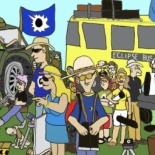 |
www.eclipse-chasers.com Properly Equipped Eclipse Chaser Author: Bill Kramer Last update: Saturday, 18-Apr-2015 11:53:59 EDT |
Eclipse Chaser
(noun) - Anyone that wants to see a total solar eclipse.  Search Eclipse Chasers Site
Search Eclipse Chasers Site |
The Properly Equipped Eclipse Chaser
-Bill Kramer
What do you bring to a total solar eclipse?
This is an easy question is you just want to see it and not bother with photography, optics, and other things that interest that amateur astronomer. Binoculars. You may or may not use them during totality. That doesn’t matter. Having them for a closer view of where ever you are in the world for the solar eclipse event is generally a good idea. I do recommend that you use them during totality for at least a little bit of time. If you don’t see anything or the view is not to your gratification, stop using them and just look. So a lightweight set of binoculars of 35mm to 50mm with a modest magnification (under 10x) is something worth considering. If that is all you need to be happy, stop reading now, the rest of this paper is for amateur astronomers who may need to make a few decisions.
For most, the decision of what you can bring along will be decided based on mass. Luggage is limited to about 20kg (about 50 pounds) and unless you want to pay extra for baggage you should not expect to bring more than one or two cases with you. Tied into mass is over all size. Airlines have restrictions on what can be brought along. A good rule of thumb is that if the package is bigger and heavier than a small set of golf clubs, you cannot bring it.
The second fact is luggage capability. Can you carry what you want to bring along in a safe and proper manner? Lenses, mirrors, and optical mounts can be particularly susceptible to the miseries of luggage travel. Even carry on is subject to aircraft vibrations and the mishandling of customs officials. Shock proof insulation, hard exteriors, and secure bindings are not a luxury – they are needed.
So what to bring? Telescope? Binoculars? Camera and lens? Tripod? The simplest answer is “as much as you can carry and manage”. It is very important to remember that totality lasts just a few minutes and you will not have a lot of time to look through various devices and run one or more cameras. I recommend a small telescope or good binoculars for viewing. In those cases you will want to have an automated camera set up running. Video and/or a wide field camera set to automatically record works well and they are not too bulky to pack. Longer lenses will require a more substantial mount and could share a platform with a small telescope. Once again, size and mass will play an important factor.
My personal recommendation is binoculars. Viewing the eclipse through a good set of binoculars is awesome. You can quickly look away and catch other features such as the horizons and people reactions. During totality (AND ONLY THEN) you can look at the corona and see multiple prominences clearly.
Should you buy solar filters for the binoculars? I don’t see why they are needed unless you want to follow the progress of the partial phases more closely. Solar glasses should NEVER be used in conjunction with binoculars (both in front and behind the optics). Solar glasses are for naked eye observation only.
Having recommended binoculars I should mention that I have brought small telescopes to eclipses in the past. The view through them is nothing short of magnificent in wide field. And photographs taken through the telescopes reveal details the eye may have missed such as smaller prominences and beads. If you have a small scope and are well practiced with it, bring it along. Otherwise you will find that a total solar eclipse is not the time to be learning how to use your telescope.
